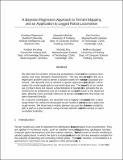| dc.contributor.author | Plagemann, Christian | |
| dc.contributor.author | Mischke, Sebastian | |
| dc.contributor.author | Prentice, Samuel James | |
| dc.contributor.author | Kersting, Kristian | |
| dc.contributor.author | Roy, Nicholas | |
| dc.date.accessioned | 2010-11-02T16:04:47Z | |
| dc.date.available | 2010-11-02T16:04:47Z | |
| dc.date.issued | 2009-10 | |
| dc.date.submitted | 2009-01 | |
| dc.identifier.issn | 1556-4967 | |
| dc.identifier.uri | http://hdl.handle.net/1721.1/59805 | |
| dc.description.abstract | We deal with the problem of learning probabilistic models of terrain surfaces from sparse and noisy elevation measurements. The key idea is to formalize this as a regression problem and to derive a solution based on nonstationary Gaussian processes. We describe how to achieve a sparse approximation of the model, which makes the model applicable to real-world data sets. The main benefits of our model are that (1) it does not require a discretization of space, (2) it also provides the uncertainty for its predictions, and (3) it adapts its covariance function to the observed data, allowing more accurate inference of terrain elevation at points that have not been observed directly. As a second contribution, we describe how a legged robot equipped with a laser range finder can utilize the developed terrain model to plan and execute a path over rough terrain. We show how a motion planner can use the learned terrain model to plan a path to a goal location, using a terrain-specific cost model to accept or reject candidate footholds. To the best of our knowledge, this was the first legged robotics system to autonomously sense, plan, and traverse a terrain surface of the given complexity. | en_US |
| dc.description.sponsorship | United States. Defense Advanced Research Projects Agency (DARPA). Learning Locomotion project (AFRL contract FA8650-05-C-7262) | en_US |
| dc.description.sponsorship | European Commission (contract number FP6-004250-CoSy) | en_US |
| dc.description.sponsorship | Deutsche Forschungsgemeinschaft (DFG) (contract number SFB/TR-8) | en_US |
| dc.description.sponsorship | Germany. Federal Ministry of Education and Research (BMBF) (DESIRE project) | en_US |
| dc.language.iso | en_US | |
| dc.publisher | Wiley Periodicals, Inc. | en_US |
| dc.relation.isversionof | http://dx.doi.org/10.1002/rob.20308 | en_US |
| dc.rights | Attribution-Noncommercial-Share Alike 3.0 Unported | en_US |
| dc.rights.uri | http://creativecommons.org/licenses/by-nc-sa/3.0/ | en_US |
| dc.source | Nicholas Roy via Barbara Williams | en_US |
| dc.title | A Bayesian Regression Approach to Terrain Mapping and an Application to Legged Robot Locomotion | en_US |
| dc.type | Article | en_US |
| dc.identifier.citation | Plagemann, C., Mischke, S., Prentice, S., Kersting, K., Roy, N. and Burgard, W. (2009), A Bayesian regression approach to terrain mapping and an application to legged robot locomotion. Journal of Field Robotics, 26: 789–811. doi: 10.1002/rob.20308 | en_US |
| dc.contributor.department | Massachusetts Institute of Technology. Computer Science and Artificial Intelligence Laboratory | en_US |
| dc.contributor.department | Massachusetts Institute of Technology. Department of Aeronautics and Astronautics | en_US |
| dc.contributor.department | Massachusetts Institute of Technology. Department of Electrical Engineering and Computer Science | en_US |
| dc.contributor.approver | Roy, Nicholas | |
| dc.contributor.mitauthor | Prentice, Samuel James | |
| dc.contributor.mitauthor | Roy, Nicholas | |
| dc.relation.journal | Journal of Field Robotics | en_US |
| dc.eprint.version | Author's final manuscript | |
| dc.type.uri | http://purl.org/eprint/type/JournalArticle | en_US |
| eprint.status | http://purl.org/eprint/status/PeerReviewed | en_US |
| dspace.orderedauthors | Plagemann, Christian; Mischke, Sebastian; Prentice, Sam; Kersting, Kristian; Roy, Nicholas; Burgard, Wolfram | en |
| dc.identifier.orcid | https://orcid.org/0000-0002-4959-7368 | |
| dc.identifier.orcid | https://orcid.org/0000-0002-8293-0492 | |
| mit.license | OPEN_ACCESS_POLICY | en_US |
| mit.metadata.status | Complete | |
